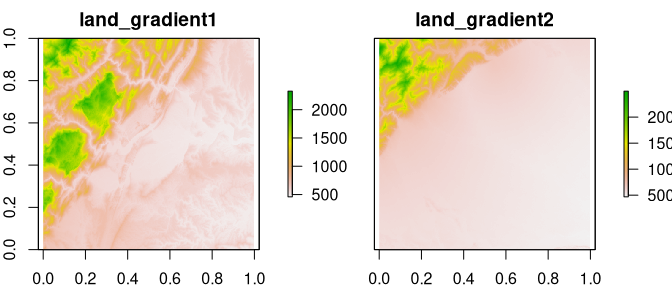Boltzmann entropy (also called configurational entropy) has been recently adopted to analyze entropy of landscape gradients (Gao et al. (2017, 2018, 2019)). The goal of belg is to provide an efficient C++ implementation of this method in R. It also extend the original idea by allowing calculations on data with missing values (Nowosad and Gao (2020)).
You can install the released version of belg from CRAN with:
install.packages("belg")And the development version from GitHub with:
# install.packages("remotes")
remotes::install_github("r-spatialecology/belg")As an example, we use two rasters - land_gradient1
representing a complex landscape and land_gradient2
representing a simple landscape:
library(raster)
library(belg)
land_gradient1 = raster(system.file("raster/land_gradient1.tif", package = "belg"))
land_gradient2 = raster(system.file("raster/land_gradient2.tif", package = "belg"))
plot(stack(land_gradient1, land_gradient2))
The main function in this package, get_boltzmann(),
calculates the Boltzmann entropy of a landscape gradient:
get_boltzmann(land_gradient1)
#> [1] 188772.5
get_boltzmann(land_gradient2)
#> [1] 121875.2This function accepts a SpatRaster, stars,
RasterLayer, RasterStack,
RasterBrick, matrix, or array
object as an input. It allows for calculation of the relative (the
relative argument equal to TRUE) and absolute
Boltzmann entropy of a landscape gradient. As a default, it uses a
logarithm of base 10 (log10), however log and
log2 are also available options for the base
argument.
get_boltzmann(land_gradient1, base = "log")
#> [1] 434664.7
get_boltzmann(land_gradient1, relative = TRUE)
#> [1] 137645.4
get_boltzmann(land_gradient1, base = "log2", relative = TRUE)
#> [1] 457248.1Two methods of calculating the Boltzmann entropy of a landscape
gradient are available: "hierarchy" (default) for the
hierarchy-based method (Gao et al., 2017) or "aggregation"
for the aggregation-based method (Gao et al., 2019). The
aggregation-based method requires that the number of rows and columns in
the input data must be a multiple of 2.
get_boltzmann(land_gradient1, method = "aggregation")
#> [1] 188772.5
get_boltzmann(land_gradient1, relative = TRUE, method = "aggregation")
#> [1] 137645.4More examples can be find at https://github.com/Nowosad/belg-examples.